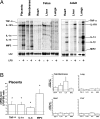Mechanism of acute fetal cardiovascular depression after maternal inflammatory challenge in mouse
- PMID: 15920144
- PMCID: PMC1602402
- DOI: 10.1016/S0002-9440(10)62469-8
Mechanism of acute fetal cardiovascular depression after maternal inflammatory challenge in mouse
Abstract
Intra-amniotic lipopolysaccharide (LPS) causes an acute inflammatory response and cardiac dysfunction in fetal mice. We hypothesized that the placenta protects the fetus against maternally administered bacterial toxins, delaying the onset of a fetal inflammatory response and vascular compromise. At 14 to 15 days of gestation, DBA mice were randomized to receive LPS (2.4 mg/kg) or vehicle intraperitoneally. Doppler ultrasonography of fetal cardiovascular hemodynamics was performed before and 6 hours after maternal LPS. Six hours after the LPS, maternal serum concentrations of tumor necrosis factor-alpha and interleukin (IL)-6 (P < 0.05) were increased. Placenta showed severe maternal vascular dilatation and congestion. The expressions of tumor necrosis factor-alpha, IL-1alpha, and IL-6 (P < 0.05) were increased, and the expression of Toll-like receptor 4 was constitutive in placenta. The expression of Toll-like receptor 2 increased (P < 0.05) and was detected in labyrinthine macrophages. No inflammatory activation was found in fetal tissues, and amniotic fluid revealed no significant increase in cytokines. The ultrasonographic examination demonstrated increased fetal cardiac afterload after LPS, with 65% of the fetuses exhibiting atrioventricular valve regurgitation. In conclusion, maternal inflammatory insult activates placental labyrinthine macrophages leading to an acute increase in placental vascular resistance and fetal cardiac dysfunction without an inflammatory response in fetus.
Figures





Similar articles
-
Intra-amniotic lipopolysaccharide leads to fetal cardiac dysfunction. A mouse model for fetal inflammatory response.Cardiovasc Res. 2003 Oct 15;60(1):156-64. doi: 10.1016/s0008-6363(03)00338-9. Cardiovasc Res. 2003. PMID: 14522418
-
Maternal endotoxin-induced preterm birth in mice: fetal responses in toll-like receptors, collectins, and cytokines.Pediatr Res. 2008 Mar;63(3):280-6. doi: 10.1203/PDR.0b013e318163a8b2. Pediatr Res. 2008. PMID: 18287966
-
Maternally administered melatonin differentially regulates lipopolysaccharide-induced proinflammatory and anti-inflammatory cytokines in maternal serum, amniotic fluid, fetal liver, and fetal brain.J Pineal Res. 2007 Aug;43(1):74-9. doi: 10.1111/j.1600-079X.2007.00445.x. J Pineal Res. 2007. PMID: 17614838
-
[The role of immune placental inflammation in the genesis of complicated pregnancy].Vestn Ross Akad Med Nauk. 2007;(9):32-7. Vestn Ross Akad Med Nauk. 2007. PMID: 18030717 Review. Russian.
-
The Inflammatory Cytokine Imbalance for Miscarriage, Pregnancy Loss and COVID-19 Pneumonia.Front Immunol. 2022 Mar 11;13:861245. doi: 10.3389/fimmu.2022.861245. eCollection 2022. Front Immunol. 2022. PMID: 35359975 Free PMC article. Review.
Cited by
-
Cardiac function and circulating cytokines after endotoxin exposure in neonatal mice.Pediatr Res. 2010 Nov;68(5):381-6. doi: 10.1203/PDR.0b013e3181efbe10. Pediatr Res. 2010. PMID: 20613681 Free PMC article.
-
Pulmonary maternal immune activation does not cross the placenta but leads to fetal metabolic adaptation.Nat Commun. 2024 Jun 3;15(1):4711. doi: 10.1038/s41467-024-48492-x. Nat Commun. 2024. PMID: 38830841 Free PMC article.
-
Inflammatory regulation of valvular remodeling: the good(?), the bad, and the ugly.Int J Inflam. 2011;2011:721419. doi: 10.4061/2011/721419. Epub 2011 Jul 18. Int J Inflam. 2011. PMID: 21792386 Free PMC article.
-
Lipopolysaccharide and soluble CD14 in cord blood plasma are associated with prematurity and chorioamnionitis.Pediatr Res. 2014 Jan;75(1-1):67-74. doi: 10.1038/pr.2013.182. Epub 2013 Oct 17. Pediatr Res. 2014. PMID: 24135785 Free PMC article.
-
The role of interleukin-1 in perinatal inflammation and its impact on transitional circulation.Front Pediatr. 2023 Mar 13;11:1130013. doi: 10.3389/fped.2023.1130013. eCollection 2023. Front Pediatr. 2023. PMID: 36994431 Free PMC article. Review.
References
-
- Rangel-Frausto MS, Pittet D, Costigan M, Hwang T, Davis CS, Wenzel RP. The natural history of the systemic inflammatory response syndrome (SIRS). A prospective study. JAMA. 1995;273:117–123. - PubMed
-
- Parrillo JE, Parker MM, Natanson C, Suffredini AF, Danner RL, Cunnion RE, Ognibene FP. Septic shock in humans. Advances in the understanding of pathogenesis, cardiovascular dysfunction, and therapy. Ann Intern Med. 1990;113:227–242. - PubMed
-
- Beutler B. Endotoxin, Toll-like receptor 4, and the afferent limb of innate immunity. Curr Opin Microbiol. 2000;3:23–28. - PubMed
Publication types
MeSH terms
Substances
LinkOut - more resources
Full Text Sources
Other Literature Sources
Medical

